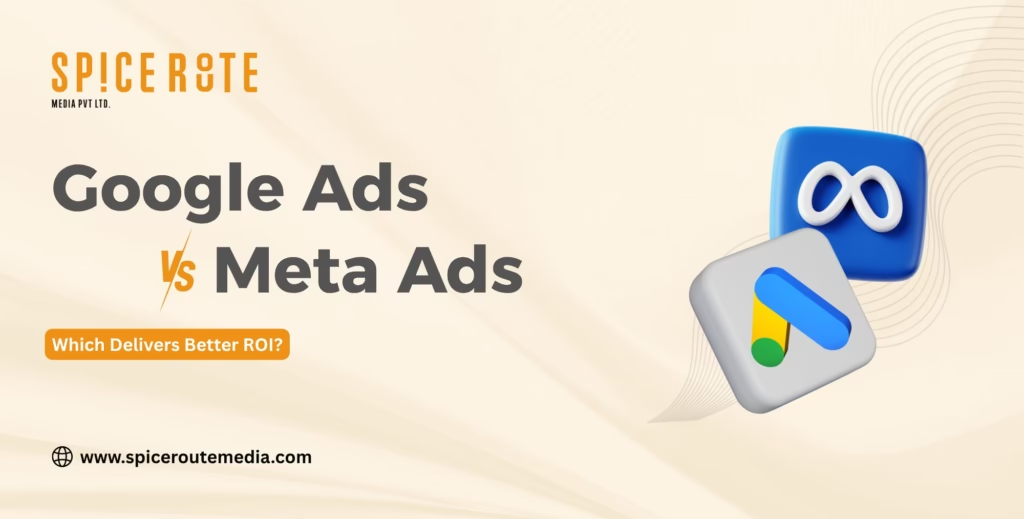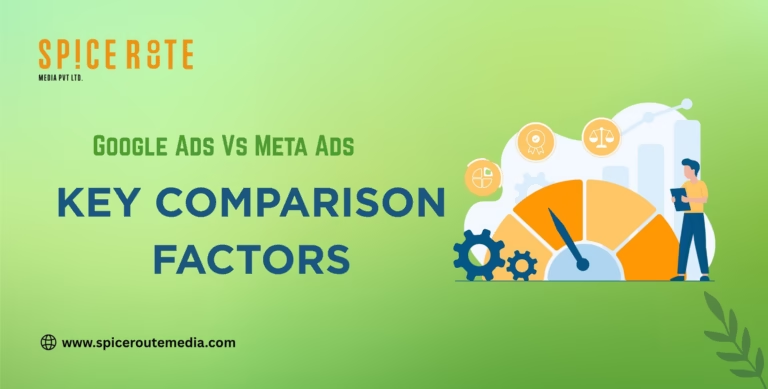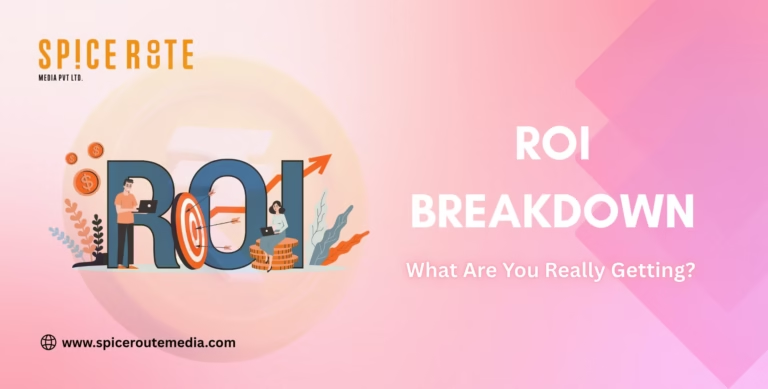Recent Comments

In 2025, the debate over Google Ads vs Meta Ads is more relevant than ever. Digital advertising is advancing quickly, and businesses are under pressure to choose the right platform for maximum ROI. Businesses are discovering that choosing which paid media services to utilize is becoming more crucial due to tight budgets, shifting user trends, and sophisticated tools for advertising targeting. Google Ads vs Meta Ads (formerly Facebook Ads) is one of the hottest debates in digital advertising today. With that in mind, which platform delivers the most return on investment in 2025?
These days, Facebook and Google are two of the most widely used platforms. Google receives over 14 billion searches daily, while Facebook has over 3 billion active members. They both offer advertising services as well.
The primary differences between Google Ads and Facebook Ads, despite their similarities, may help you in selecting the one that best meets the needs of your company. Remember that the best AdWords management businesses provide campaigns that maximize return on investment. This entails deciding on the best advertising platform and ensuring that the strategy fits the needs of your company.
Understanding the Basics
What Are Google Ads?
Google Ads is a pay-per-click (PPC) advertising network provided by Google, the most widely used search engine globally. In addition, keyword targeting is one of its most popular tactics, especially when using the Google Search Network. Because of this, choosing the right keywords is crucial for appearing in relevant search results.
In terms of intent, Google Ads is the best service.
When individuals search, Google Ads typically show up based on their search intent. We may infer from a Google search that someone searching for “best running shoes” or “accounting software for startups” is trying to find a solution to their issue. Google Ads is particularly effective at generating sales conversions close to the end of the consumer journey because of this high eagerness to buy.
Google advertisements now offers YouTube, Display Network, Shopping, and Discovery advertisements in addition to Search, allowing advertisers to reach consumers at various stages of the purchasing process.
What Are Meta Ads?
Businesses can contact consumers on Facebook, Instagram, Messenger, and the Meta Audience Network with Facebook Ads, which is part of the broader Meta Ads ecosystem. Through this approach, your company reaches people who might not have been actively searching but are still likely interested based on their behavior. Additionally, Facebook ads appear as sponsored posts in users’ newsfeeds.
Sponsored social media adverts that appear in users’ newsfeeds are called Facebook ads. They are referred to as “sponsored” in order to denote sponsored material. Facebook offers a wide range of ad formats, including collections, slideshows, carousels, images, and videos.
Then there are ads on Meta (Facebook and Instagram), which are directed at people finding and interacting with your company. Instead of deliberately searching for anything, users of Meta apps utilize the features to scroll, engage, and connect. If they hadn’t noticed it previously, your advertisement will automatically appear in their feed and spark their curiosity.
Meta is great for increasing brand awareness and promoting everyday products. To reach audiences, you take into account their interests, online activities, and potential consumers.

Google Ads vs Meta Ads — Key Comparison Factors
1.Audience Targeting
Google Ads
Targeting by Keyword and Demographic
You can target with Google based on:
- Search intent keywords
- The demographics
- Device Location
- Personalized audiences (via Google Signals)
It’s great for reaching individuals who are actively looking to buy what you have to offer.
Meta Ads
Meta’s strength is found in:
- Interests and Behaviours (e.g., device usage, buying habits)
- Audiences that look alike
- Retargeting with pixel information
Even though Meta’s tracking capabilities are more limited, its revamped strategy and 2025 advertising are helping marketers stay competitive.
2.Cost per Click (CPC)
Google Ads
Google Ads often comes with a higher CPC, especially in competitive industries such as finance, law, or tech. However, the users reached through search often have strong purchase intent, making the higher cost worthwhile when it leads to sales.
Meta Ads
Typically offers a lower CPC, making it well-suited for early-stage marketing campaigns focused on awareness, engagement, and building an audience.
3.Driving Conversions
Google Ads
Excels at capturing high-intent users who are actively searching for products or services. With well-optimized campaigns, clicks often translate into direct sales or leads, making it a strong choice for conversion-focused strategies.
Meta Ads
Can drive conversions effectively through retargeting, personalized creatives, and lookalike audiences. However, it often requires a longer nurturing process, as many users aren’t actively searching when they see the ad.
4.Analytics & Optimization
Google Ads
Offers robust, keyword-level performance data, advanced attribution models, and real-time insights. Integration with Google Analytics provides deep tracking and optimization opportunities for campaigns.
Meta Ads
Provides strong audience insights and ad performance metrics, but tracking is more limited due to privacy changes. Still, its built-in AI-driven optimization tools and creative testing features help improve results over time.
When to Make Use of Google Ads
- You market products or services that customers actively seek out.
- Your target market is searching online.
- You must see results fast.
- Your budget for competitive bidding is sound.
When to Make Use of Meta Ads
- You wish to raise awareness of your brand.
- Visual storytelling complement your product beautifully.
- Your audience is active on Facebook and Instagram.
- The length of your sales process is longer.
When ROI Is Better with Google Ads
- You provide a high-end good or service (real estate, plumbing, law, etc.).
- You’re looking for quick leads or sales.
- People in your audience are actively looking for information online.
- You’re aiming for high-end or business-to-business services.
For instance, a Google Search Ad is more likely to result in a conversion for a visitor who searches for “best digital marketing agency near me.”
When ROI Is Better with Meta Ads
- You provide a high-end good or service (real estate, plumbing, law, etc.).
- You’re looking for quick leads or sales.
- People in your audience are actively looking for information online.
- You’re aiming for high-end or business-to-business services.
For instance, a Google Search Ad is more likely to result in a conversion for a visitor who searches for “best digital marketing agency near me.”

Choosing Between Google Ads vs Meta Ads for ROI
Google Ads
The primary objective of Google Ads ROI measurement is accuracy and purchasing.
Advantages:
- When people understand why they are on these websites; conversion rates are higher.
- Only when people click on your advertisements do you get compensated.
Relevant online visitors for businesses that provide goods and services
Cons:
- Cost in those areas of the market where there is a lot of rivalry
- Small and simple stories
- It must be updated by continuously modifying the keywords and bidding.
Meta Ads
Advantages:
- Using YouTube as a partner can help you retarget visitors and promote your brand.
- Effective utilization of strong visuals and innovative, inventive techniques
- CPCs are getting cheaper across a range of businesses.
Cons:
- It is common for viewers to grow weary of the same advertisements; thus, fresh creatives are required on a regular basis.
- Purchase intention is lower than search traffic.
- After the iOS14 release, it can occasionally be challenging to attribute direct-tracking findings.
Real Examples of Google Ads and Meta Ads in Action
Google Ads
Verve Coffee Roasters – A Northern California coffee brand that optimizes Google Search Ads by offering multiple, targeted click-through options.
In one ad appearing at the top of a relevant search results page, each of the four links leads to a different landing page:
- Best Selling Subscription – Highlights its signature product.
- Save 15% With 5 lbs Bags – Promotes a limited-time sale.
- Find Your Coffee Match – Interactive quiz to guide product selection.
This approach directs users to the most relevant part of the site for their needs, increasing engagement and conversions across different customer types.
Meta Ads
Allbirds – The sustainable footwear brand uses Meta Ads to blend product storytelling with direct response elements.
In a Facebook and Instagram campaign, Allbirds showcases lifestyle imagery of people wearing their shoes in real-world settings, paired with concise captions emphasizing comfort, sustainability, and free shipping. The ads often include:
- Shop Now – Direct link to featured product pages.
- Learn More – Routes to a sustainability story or brand mission page.
- Limited Edition Drop – Creates urgency with time-sensitive offers.
By combining visually engaging creative with interest-based targeting and retargeting, Allbirds drives both brand affinity and sales, even among audiences not actively shopping for shoes.
Conclusion
Both Google Ads vs Meta Ads can deliver strong returns—but the right choice depends on your business goals, audience, and budget.
If you need high-intent leads quickly, Google Ads is often the better fit, especially for industries with urgent purchase intent like legal, home services, and B2B. If your aim is brand awareness, community building, and nurturing interest, Meta Ads excel with their visual storytelling and precise audience targeting.
The most effective advertising strategies often combine both platforms—leveraging Google Ads for immediate conversions and Meta Ads for sustained engagement and remarketing.
Need Expert Help Deciding?
At SpiceRoute Media, we help brands create high-ROI ad campaigns that align with your objectives—whether on Google, Meta, or both. From targeting and creative strategy to campaign optimization, our team ensures you get measurable results.
Contact us today to discover how we can maximize your advertising ROI.
- No Comments



